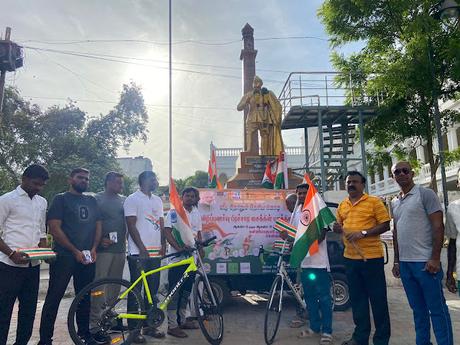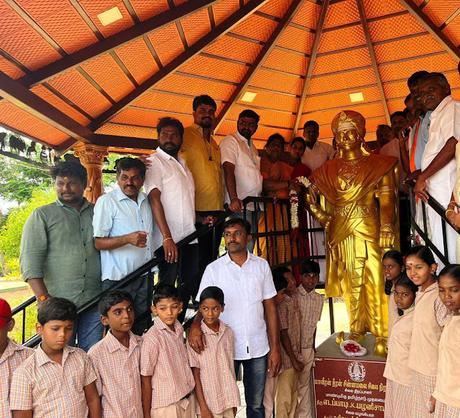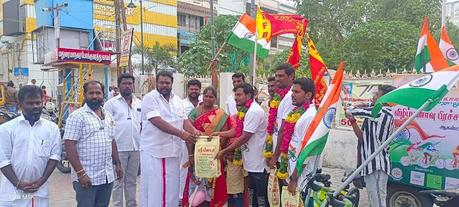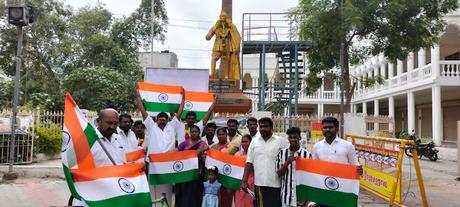Do you know train no. 12633 and can you say its originating and destination stations ?
A flag is a symbolic representation of a Nation and its principles. It is considered a symbol of pride and is unanimously associated with the nation’s spirit and ethos. The National flag of India in its current form was first adopted during the Constituent Assembly held on July 22, 1947. This was a few days before India's independence from the British was declared.
The term "triranga / tricolour" always refers to the Indian national flag. The flag is based on the Swaraj flag, a flag of the Indian National Congress designed by Pingali Venkayya. The flag, by law, is to be made of khadi. The manufacturing process and specifications for the flag are laid out by the Bureau of Indian Standards. Usage of the flag is governed by the Flag Code of India and other laws relating to the national emblems. In 2002, on hearing an appeal from Naveen Jindal, the Supreme Court of India directed the Government of India to amend the code to allow flag usage by private citizens. Subsequently, the Union Cabinet of India amended the code to allow limited usage. Karnataka Khadi Gramodyoga Samyukta Sangha (KKGSS) is a manufacturing federation located in the Bengeri area of the city of Hubli in the Karnataka, is the only unit in India that is authorised to manufacture and supply the Flag of India.
Prime Minister Hon'ble Shri Narendra Modiji urged the Nation to put the "tiranga" ('tricolour', the national flag) as their display pictures on social media profiles between August 2 and 15. In his 'Mann Ki Baat' radio broadcast, he flagged a movement called 'Har Ghar Tiranga' (tricolour on every house) being organised from August 13 to 15. The patriotic citizens responded with fervor. More than six crore selfies with the National flag have been uploaded on ‘Har Ghar Tiranga’ website
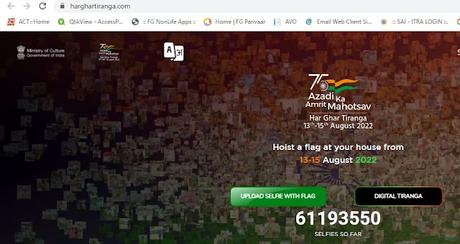
‘Har Ghar Tiranga’ is a campaign under the aegis of Azadi Ka Amrit Mahotsav to encourage people to bring the Tiranga home and to hoist it celebrating India’s independence. Our relationship with the flag has always been more formal and institutional than personal. Bringing the flag home collectively as a nation in the 75th year of independence thus became symbolic of not only an act of personal connection to the Tiranga but also an embodiment of our commitment to nation-building. The idea behind the initiative was to invoke the feeling of patriotism in the hearts of the people and to promote awareness about the Indian National Flag.
The Flag Code of India, 2002 was amended vide Order dated 30th December, 2021 and National Flag made of polyester or machine made Flag have been allowed. Now, the National Flag shall be made of handspun and handwoven or machine-made, cotton/polyester/wool/silk/khadi bunting.
Looking back at some of the events connected with the making of National flag : in Dist Sangli, Maharashtra, people of Bilashi village uprooted a teak tree in defiance of the forest laws of the British Government, placed it near the village temple on 18 July 1930 during the Civil Disobedience movement and also hoisted the National flag on its shaft. On 5 September 1930, a band of 300 armed policemen arrived at the place to take away the National Flag. This police act was vehemently resisted by the gathering of the local people there, resulting in indiscriminate police firing. Sitaram Chambhar, a 12 year youth was killed in that firing on the spot.
Another incident occurred in 1931 in Kakinada in East Godavari District of Andhrapradesh. Combining civil disobedience movement, on the occasion of the Venkateswaraswami Chariot/Car Festival in Vadapalli, on 30 March 1931, along with the deity, a Tricolour flag and photos of Mahatma Gandhi, and some other national leaders adorned the car. This was objected by the Government officials, and when the procession was about to start, the Sub-Inspector of Razolu removed the portraits of the national leaders. People resented the act and refused to draw the car without the portraits. Over this issue, a riot broke out at Chinnavadapalli. Police resorted to indiscriminate firing on the crowd, killing innocent people that included Bandaru Narayanaswami, Tatapati Venkatapatiraju & Vadapalli Gangachalam.
The history of the Nation as handed by Colonial rulers, appreciated by Congress and Commies had no place for such martyrs is melancholic.
This time the spirit of freedom resonated across the Nation. Many people participated enthusiastically in the programme and adopted it as their own. From Kashmir to Kanyakumari, from Kibithu to Kutch, one could see the infectious energy and the sense of ownership with which India participated in the movement. This can be attributed to what the flag signifies to every Indian.
On August 13, while felicitating the Indian athletes who participated in the 22nd Commonwealth Games in United Kingdom, Prime Minister Shri Narendra Modiji touched upon the role of the Tricolour as a driving force in fostering unity and pride. Addressing the athletes, the PM said that irrespective of the state, district, or village they belong to, their overwhelming desire is to perform their best for India. The PM pointed out that the Tricolour served as a protective shield for those stranded in Ukraine (and were evacuated under the flag). It became a symbol of protection and safety not only for Indians, but also for people of other countries who were evacuated from the battlefield by the Indian government.
There were thousands of concerted efforts across the Nation in ‘Har ghar Tiranga’ campaign. In one such campaign, youth of Nethaji Movement from Erode organized a cycle rally from Kanyakumari to Chennai. Scores of youth of bicycle started from Kanyakumari, traversed the distance in 8 days crossing 800 odd km, stopping at various places, distributing National flag and speaking on its glory. The rally concluded at Bharathiyar illam at Triplicane. Enroute BJP volunteers cheered them and made arrangements for their stay and rest in the night.
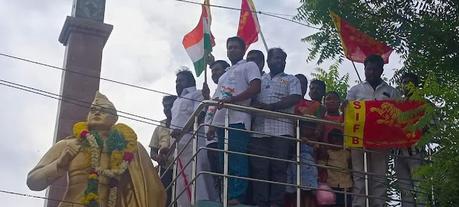
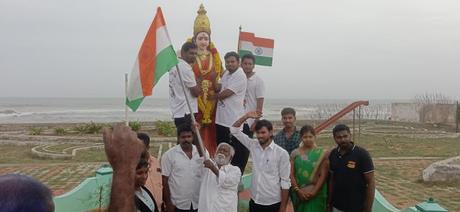
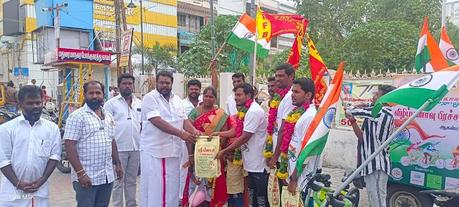
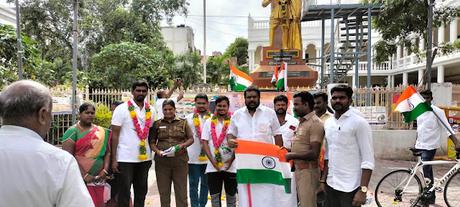
We at SYMA were delighted when two of the rallyist Dr Ranjithkumar and Mr KUmaravel visited our exhibition on freedom struggle at NKT Girls High school and were honoured with shawl on our podium by Ms YG Madhuvanthi.
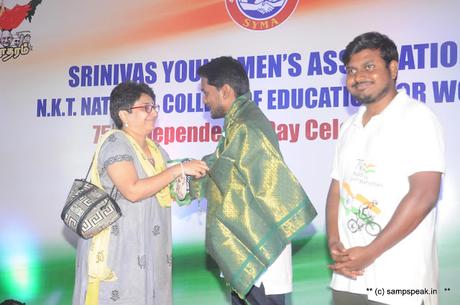
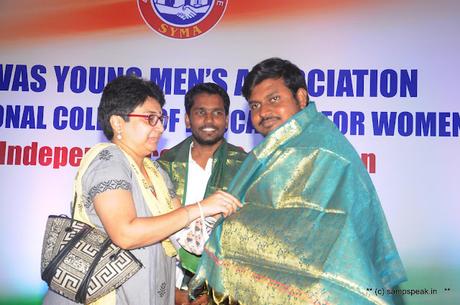
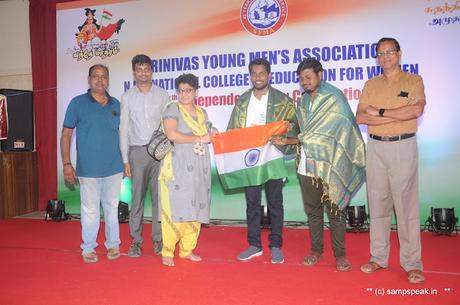
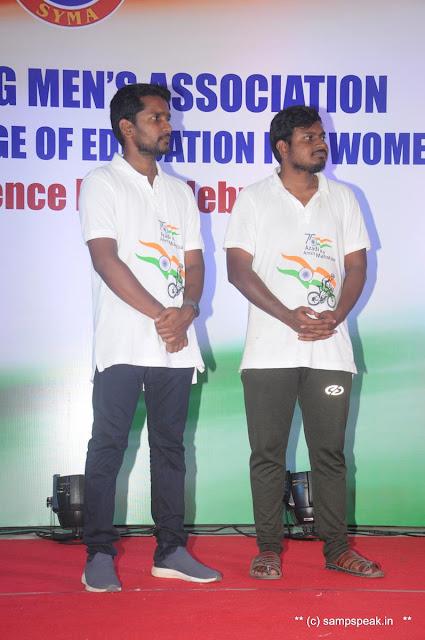
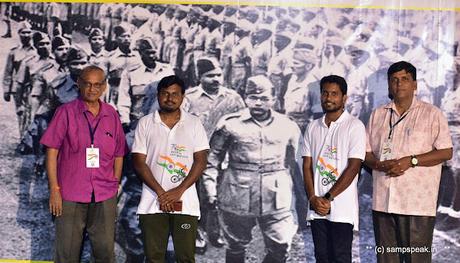
Nation is above everything – we love our Nation, and SYMA appreciates Dr Ranjit and KUmaravel and his team of volunteers who traversed Tamilnadu by cycle.
With regards – S. Sampathkumar18th Aug 2022.
